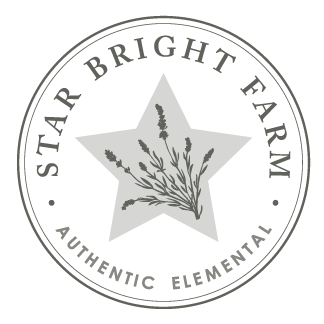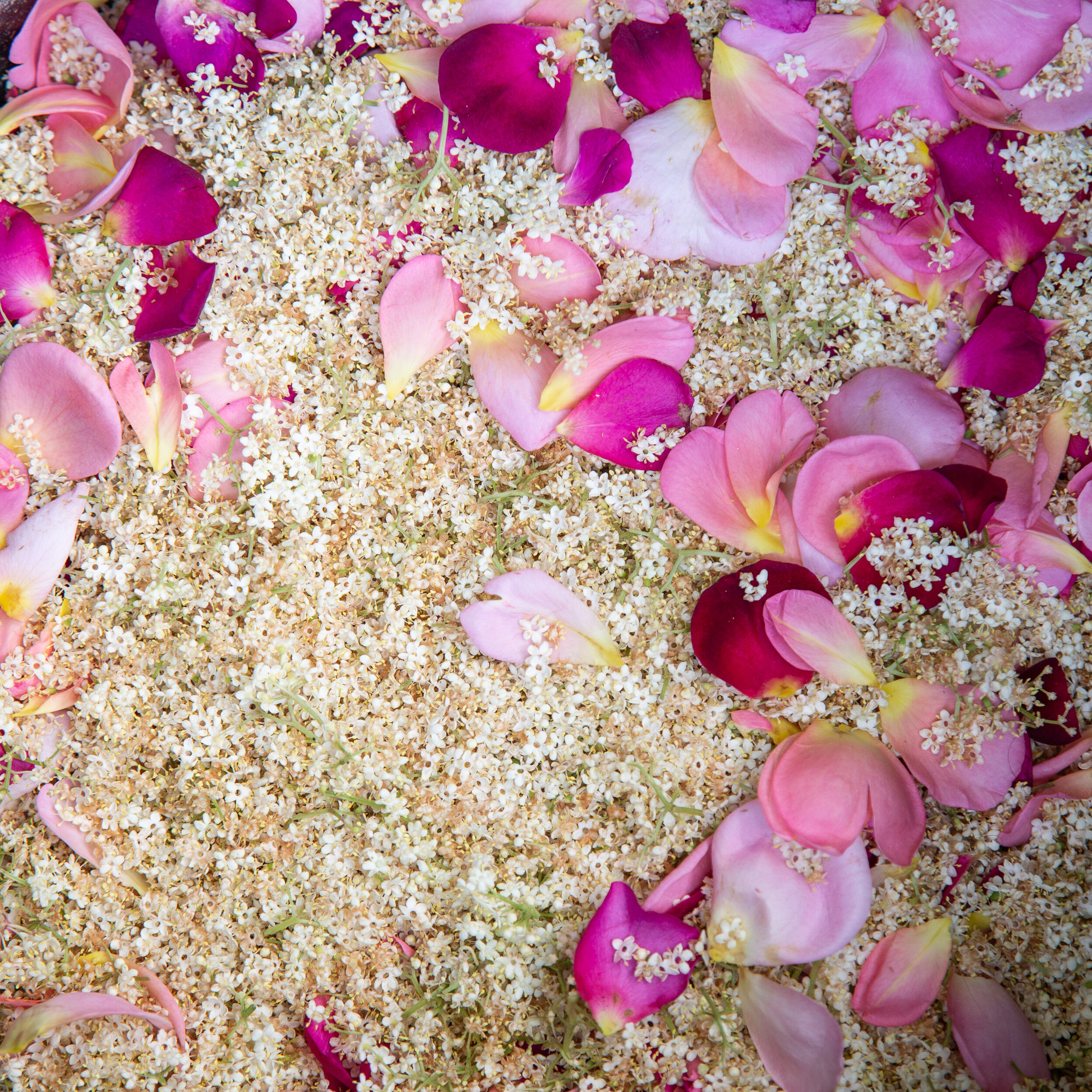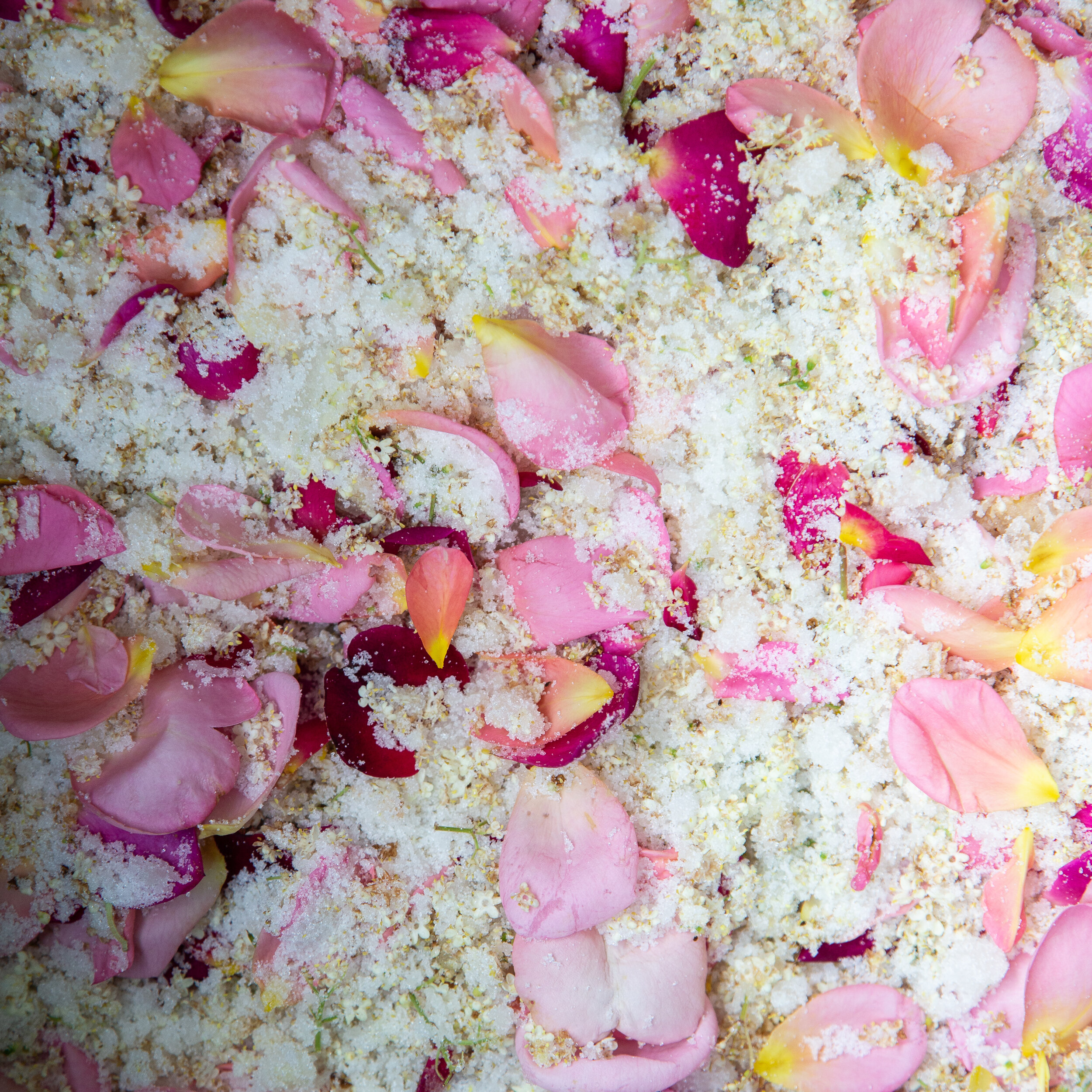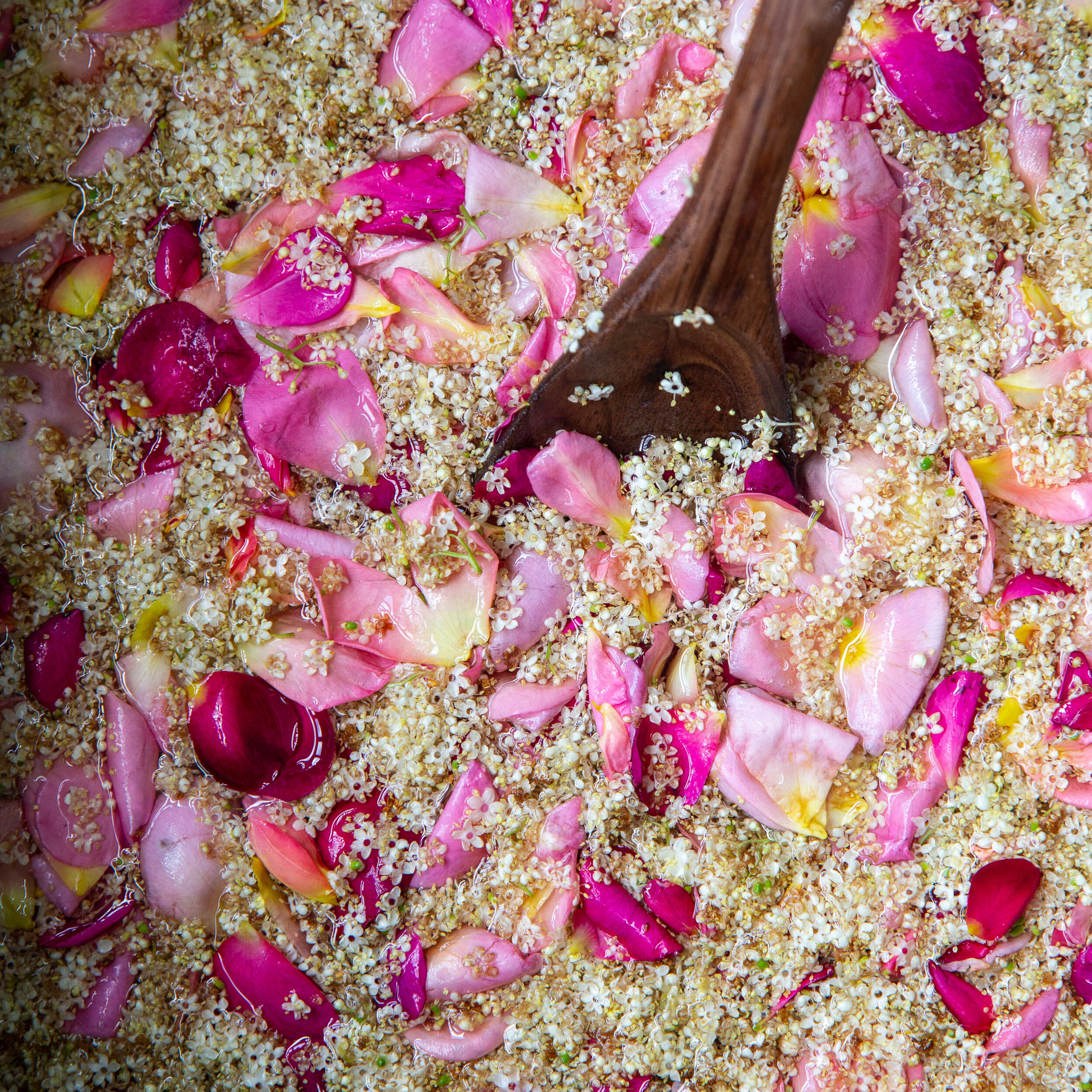Celebrate Each Harvest of the Season: Elderflower and Garden Roses
We are frequently just referred to as “ the beautiful Lavender Farm” Yes, we do grow 4000 lavender plants. But really we are a diversified Herb, flower and small fruit farm. In the background of the sensation of Lavender, we are growing 24 aromatic and medicinal herbs, and constantly expanding our cultivation of small fruits and flowers.
This week we celebrate the harvest of Elderflower and English Garden Roses.
Flowering Elderberry Tree
The Elderberry tree is known both for it’s delicate flowers and fruit. The lacey flowers have the sweetest floral scent and flavor.
“An elderberry bush or small tree (depending on where you live), is a perennial, surviving in zones 3 – 8. It likes sun or partial shade, although it produces less fruit in shady areas. It prefers nitrogen-rich soil, but tolerates poor soils, and is found everywhere from creek sides to forest edges and ditches. If you have an elder in your yard, be careful with a tiller around it, since they have a shallow root system and can be easily damaged.
Elder belongs to the Caprifoliaceae, or honeysuckle family, although there has been talk of reclassifying it into the Adoxaceae, or viburnum family. The nigra is native to Europe, North Africa, and western Asia. Canadensis is native to North and Central America. Elder has opposite, compound leaves composed of five to nine oval and toothed leaflets. The leaves are dark green, but lighter on the underside. The bark is gray or light brown.
The stem’s pith allows it to be hollowed out with ease, and it has been used as a tap for collecting maple sap. Kids have also been known make whistles and pea shooters from the hollowed stem. Traditionally, the pith was saved to use for starting fires.” (The Herbal Academy ) Head to the website for more info on the beauty of the Elderberry Tree and it’s flowers!
Roses and their many uses in the kitchen:
“The Greeks, Romans and Persians were all partial to cooking with roses -using them to infuse oils and medicinal waters, or to add natural sweetness. The Persians developed a technique to steam rose petals to extract the perfumed oil, and obtained rose water as a by-product. This technique then spread to India and Arabia and successively to Europe via the Bulgarian Rose Valley, which today produces the largest percentage of the world’s rose oil.
Persians, Greek and Romans also used rose petals to decorate their banquet tables. The poet Horace references this in his odes, for example in this passage: “O command now that the wines be brought forth / and the perfumes, and the blossoms all too brief / of the rose whilst circumstances yet permit […].” Roses were considered as a symbol of purity and used in ceremonies such as weddings, but also funerals.
The Victorian loved flowers: they created a complex language of flowers and often used them into their food. Together with the rise of sugar plantation in British colonies, the Victorians favoured the look of candied flowers and flower-encrusted sweets and pastries.
To this day in Western culture you can find rose and rose petals more often in desserts and other sweet dishes. Rose pairs wonderfully with fruits such as passion fruit, raspberry and lychee, dried apricots and honey. Many Middle Eastern desserts and confections feature rose and rose water: Turkish Delights are a rose-flavoured favourite, so much so that they have inspired my Lavolio Rose Jellies, but also rose cakes, rose ice cream and other floral sweets.
On the other side, in many cuisines rose features in savoury dishes as well: in the Middle East; in North Africa, in the spice mix ras el hanout, together with other spices, dried rose petals are seasoning for poultry, lamb and other meats; in India, rose water is an ingredient in Kashmiri Biryani. Roses pair wonderfully with cheeses like buffalo mozzarella and brie; with vegetables such as tomato and aubergine and with herbs like basil and tarragon.
Any variety of roses can be used for cooking (as long as they are free of chemicals and pesticides). Damask roses, Garden roses, heirloom, Rosa Rugosa and “Generous Gardener” are all wonderful varieties for cooking. You can also use any pink, yellow and some white roses.” ( Lavolio )
Below are some useful tips on how to incorporate roses into your culinary life. From the blog Ode a la Rose
Rose-infused beverages: Rose petals can add a subtle floral taste to lemonades, juices and iced tea. Simply muddle fresh rose petals to release the flavor, and stir them into a cool, fruity beverage. Rose petals can also be frozen into ice cubes for a beautiful and delicious punch.
Rose simple syrup: Mix equal parts sugar and water in a saucepan and bring it to a boil. Stir continuously until the sugar is completely dissolved. Reduce to a simmer and stir in dried or fresh rose petals. Remove the mixture from the heat and let it steep for about 10 minutes. Strain out the rose petals with a fine sifter, and allow the syrup to cool. Rose simple syrup is delicious in cocktails, tea and lemonade.
Rose sugar: Chop up one-half cup of rose petals and mix them with two cups of sugar. Pour the sugar into a covered tin and store it in a cool, dark location for about one week. Sift the sugar through a sieve into a clean glass jar to remove the petals. A few of them can remain. This floral sugar is perfect for tea or to sprinkle on top of sugar cookies.
Candied flower petals: Candied flower petals are perfect as an edible garnish for cakes and desserts or simply a sugary after-dinner treat. This recipe can be made with roses or any other edible flower. Paint each petal or flower with gently beaten egg whites, then dip it in granulated sugar. Lay the petals on wax paper to dry until hardened.
Salads with rose: Fresh rose petals make a great addition to fruit salads and mixed greens salads. Create a salad filled with other herbs and flowers from your garden for a refreshing summer lunch.
Dried rose in granola: Add dried rose petals to a sweet granola mix with dried cranberries, apricots and honey. This floral granola pairs well with vanilla yogurt or can be eaten plain as a healthy snack.
Rose butter: Chop up fragrant rose petals and mix them into softened butter. Pack the butter into a ramekin and chill until it’s ready to serve. You can also add finely ground sugar or almond extract for extra sweetness. This delicate butter is perfect served on biscuits, crackers or fruity muffins.
Rose water: Rose-infused water offers a great way to incorporate the flavor of rose into an entire dish, such as a custard, sponge cake or other baked goods. Rose water can also be added to beverages or used as a perfume or toner. Spritzing rose water on your face and neck will refresh and tighten your skin.
Here at Star Bright Farm we created a recipe that brings these two ingredients together in one beautiful lightly floral cocktail: An Elderflower Rose Petal Gimlet






